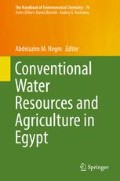Abstract
Egypt established fixed boundaries thousands of years ago. The area of the country is approximately one million square kilometers. The cultivated portion of the country does not exceed 5% of the total; while the inhabited portion is no more than 8%. The Nile River crosses the country from south to north. The irrigated area on the floodplain of the river is a narrow strip on both sides which forms the Nile Valley. The Nile Delta starts north of the capital city, Cairo, and ends close to the coast of the Mediterranean. Although Egypt is known as the “gift of the River Nile,” many Egyptian scholars prefer to call Egypt “the gift of the Egyptians” – who managed to train the River, to irrigate the lands, and to build one of the most ancient civilizations in the world.
Access this chapter
Tax calculation will be finalised at checkout
Purchases are for personal use only
References
Kady M (1984) River Nile and the history of irrigation in Egypt. Ministry of Public Works and Water Resources, Egyptian Commission for Irrigation and Drainage, Cairo, pp 73–249 (in Arabic)
Saudi A-AM (2001) History of irrigation development in Egypt (1882-1914). History of the Egyptians series, No. 196. General Egyptian Authority for Books Publisher, Cairo, pp 82–91
Mohammed MA (2001) River Nile, reading for all festival. Family library series. General Egyptian Authority for Books Publisher, Cairo (in Arabic)
Lodvig E (2000) Nile: life of river, reading for all festival. Family library series (translated to Arabic by Adel Zeithar). General Egyptian Authority for Books Publisher, Cairo
El Kady MM (1999) History of irrigation development in Egypt. Ministry of Water Resources and Irrigation, Cairo (in Arabic)
El Kady M, El Kady M (1990) History of exploration and hydrological studies of the Nile Basin. In: Fourth special session on history of irrigation, drainage and flood control, International Commission on Irrigation and Drainage, pp 77–91
El Kady M, Amer MH (1990) History of irrigation in Egypt. In: Fourth special session on history of irrigation, drainage and flood control, International Commission on Irrigation and Drainage, pp 55–76
Abu-Zeid M (1989) Land drainage in Egypt. In: Amer MH, De Ridder NA (eds) History and future role of water development and management in Egypt. MWRI, Cairo, pp 23–42
El Zanaty & Associates (1998) Knowledge, attitudes and practices of Egyptian farmers towards water resources. A national survey, Oct, pp 17–28
Author information
Authors and Affiliations
Corresponding author
Editor information
Editors and Affiliations
Rights and permissions
Copyright information
© 2017 Springer International Publishing AG
About this chapter
Cite this chapter
ElQuosy, DE. (2017). Evolution of Irrigation in Egypt. In: Negm, A.M. (eds) Conventional Water Resources and Agriculture in Egypt. The Handbook of Environmental Chemistry, vol 74. Springer, Cham. https://doi.org/10.1007/698_2017_70
Download citation
DOI: https://doi.org/10.1007/698_2017_70
Publisher Name: Springer, Cham
Print ISBN: 978-3-319-95064-8
Online ISBN: 978-3-319-95065-5
eBook Packages: Earth and Environmental ScienceEarth and Environmental Science (R0)

